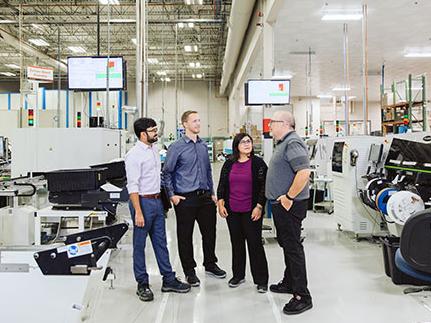
Posted to News on 15th Nov 2023, 15:45
OEMs, tech partners and end users comprise magic triangle

Design improvements and data tools were two elements discussed during the keynote presentation of the OEM Leader to Leader Summit during Automation Fair 2023 as a means to tackle supply chain disruption.
Disruption in the global supply chain has left companies with lingering pressures that have swollen to a transformation point along this leg of the innovation journey. Machine builders have found themselves caught in the middle, looking to technology partners for the tools they need to give factory end users what they want when they want it.
“The big challenge to the supply chain has been disruption,” explained Paolo Butti, vice president of OEM and emerging industries at Rockwell Automation. “We need to keep building resilience and strength. We know the supply chain has been forcing you to accelerate machine redesign.
“When we look into the market, we see a strong demand for new machines and retrofits, but not everyone goes at the same speed. In the service area, there’s a different demand from the end user. We’ve entered a transformation point, accelerating the innovation path.”
Customers’ highest-priority business imperatives are driving faster innovation and embracing new technology standards; meeting end-user performance demands; staying ahead of workforce challenges; and elevating competency, said Butti. These involve reskilling and upskilling existing employees, onboarding new employees to make them productive as quickly as possible and addressing cyber needs and threats.
“How do we convert the market outlook into the way you’re driving achievement?” asked Butti. “We want to drive innovation with rapid adoption and continuous deployment. The concept phase is when you design your machine. How do you do that?” Technology fit, application purpose, performance and value prediction all must be considered.
“The design phase is where everything that was ideated in the concept phase is proven,” continued Butti. “Everything – proof of target, verification and acceptance, knowledge transfer and future-proofing – is moving more into the digital world. Future-proofing is the new paradigm of flexibility. We call it machine adaptation.”
Butti also acknowledged the shift from a machine-based focus to a service-based focus. “The service component is essential,” he stressed. “There’s a continuous demand for optimisation and throughput, enhanced capabilities, new compliances and value adaptation.”
The next generation of innovation is being adopted, and disruption and experience capture are part of the business model. “During the machine lifecycle, there’s a process of capturing experience,” explained Butti, who cited the importance of the machine builder, technology partner and end user working together, referring to it as a magic triangle. “How do we capitalise on the learning and make sure the machine gets improved?”
Modern design and data-ready equipment are two important steps toward that end, and Rockwell Automation is focused on enabling both.
Collaborative design
“Active design has become a much more collaborative experience,” explained Dan DeYoung, vice president of product management for software and control at Rockwell Automation. “It’s turned into a variety of people working in collaboration. Our aim is to do this from anywhere and at any time with the lightest-weight tool – a web browser. We want to build, test and commission hardware virtually, ensuring first-time-right quality.”
Being able to remotely deploy updates and troubleshoot problems saves time and money, he added. “We want to enable and scale the workforce, leveraging the portfolio we have,” explained DeYoung.
By making four of FactoryTalk Twin Studio’s design tools – Arena, Studio 5000 Logix Designer, FactoryTalk Logix Echo and Emulate 3D – available in a cloud environment, the tools are accessible from a web browser, making designs scalable across teams in multiple locations. Upgrades and changes can be validated, and commissioning done virtually. Plus, development expenses can be scaled to actual usage. “It’s taking our existing software tools and making them available to leverage in the modern environment.”
FactoryTalk Design Studio’s modern, multi-user environment is also multi-controller, said DeYoung. “Collaboration tools support scalable teams,” he explained, “but it was also intentionally designed to allow multiple controllers in a single project.”
A new capability, part of a collaboration with Microsoft, includes a plug-in to FactoryTalk Design Studio that can use generative artificial intelligence (AI) to write code. “You still need to validate it,” cautioned DeYoung, “but it’s really changing the conversation.”
Visualising data flows
In addition to FactoryTalk’s design upgrades, FactoryTalk Hub is generating the next wave of data-ready equipment, which can empower workforces with an open and interoperable architecture. FactoryTalk Optix edge management and FactoryTalk DataMosaix data platform can optimize the data flow and associated costs based on customers’ IT choices, explained DeYoung.
“This enables new business models through service offerings, leveraging architecture and structured data, which can be turned on at a later time,” he said. “FactoryTalk Optix is a platform that came to us through the acquisition of ASEM. It leverages the hardware that ASEM had been building, but it brings data visualization into our portfolio.
“Optix can be on-prem or in a cloud environment. It’s dynamically synchronised, and it’s scalable. We can deploy it on a panel, on a PC, on a server, in the cloud. It’s a hyperflexible environment. At the heart is OPC UA, so it can work with virtually every manufacturer in the market.”
Meanwhile, FactoryTalk DataMosaix was born out of the oil and gas industry. “It has an inherent machine-learning capability,” explained DeYoung. “The visualisation tools it offers can analyse disparate data. Its scalability is excellent, as well.”
FactoryTalk DataMosaix’s ability to collect data on hundreds of machines in a manufacturing site makes it scalable, and it can deploy applications for a variety of industries, said DeYoung.
Following Butti’s and DeYoung’s keynote presentations, summit participants broke into four groups, discussing risk reduction in the face of complexity; how to cultivate the customer experience with after-market services; valuation of machine data; and evolving workforce issues.
Want the latest machine building news straight to your inbox? Become a MachineBuilding member for free today >>

















